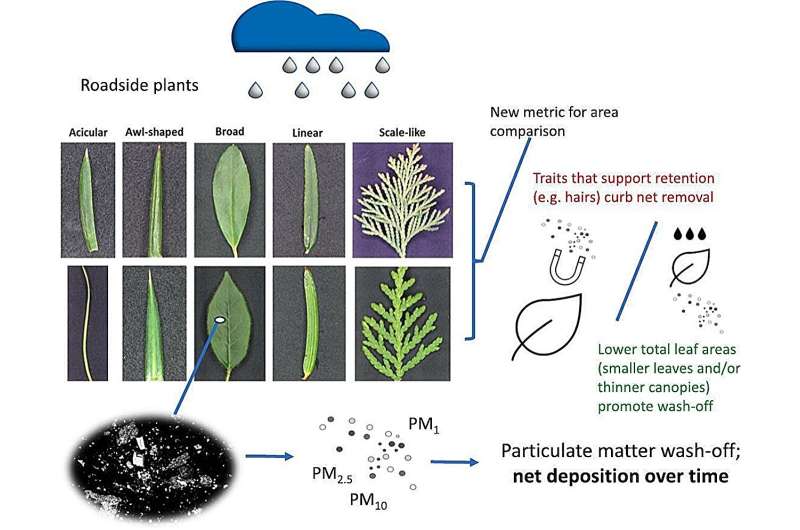This article has been reviewed according to Science X's editorial process and policies. Editors have highlighted the following attributes while ensuring the content's credibility:
fact-checked
peer-reviewed publication
trusted source
proofread
Research finds evergreens with smaller leaves offer better air pollution mitigation

If you're trying to take pollution out of the air, choose evergreen trees with smaller leaves. That's according to a new study from the University of Surrey.
Researchers from Surrey's Global Center for Clean Air Research (GCARE) tested 10 trees beside a busy main road. They studied which caught the most particles of pollution and which best allowed the rain to wash those particles safely to the ground.
The paper, which helps promote the UN Sustainability Goals 3, 11, 13 and 15, is published in the journal Science of the Total Environment.
It had been thought that leaves with rougher surfaces and minute hairs would catch more pollutants. Yet that wasn't borne out by the evidence.
Yendle Barwise, former forester and University of Surrey researcher, said, "When tackling air pollution, the ideal leaves cling on to particles when it's windy—but let go of them in the rain. That means the wind blows less pollution back into the air—but rain can wash it safely to the ground.
"Being rough and hairy isn't all it's cracked up to be. To remove more particle pollutants over time, leaves need to be washed by rainfall, and it seems that the size and shape of the leaf is much more important from this perspective."
Many planting projects use deciduous trees, which lose their leaves in winter—even though that's when air pollution is worst in towns and cities. For that reason, scientists chose ten evergreen specimens and placed them in plant pots beside the A3 in Guildford. Some 80,000 vehicles drive past every day.
Of those studied, Yew (taxus baccata) was the plant which removed most air pollution. The most effective leaf types were awl-shaped. They were found on Japanese cedar (camellia japonica) and Lawson's Cypress (chamaecyparis lawsoniana).
The study also suggested that stomata—the 'pores' of the leaf—could help plants 'catch' particles. For Yew, more particles of pollution gathered on the porous underside of the leaf. That's despite the other side of the leaf being 47% rougher, and despite previous research suggesting roughness mattered more.
Professor Prashant Kumar, founder of the University of Surrey's Global Center for Clean Air Research, said, "We know that planting trees by roadsides can make a big difference to air quality. Our study shows that by choosing your trees carefully, that difference can be even bigger."
"We've shown that smarter choice of plants can take even more pollution out of the air. We just studied the shapes and textures of the leaves themselves. Other factors, like the tree's height, leaf chemistry, or how many trees you plant, could also make a big difference. Those are well worth investigating in the future."
More information: Yendle Barwise et al, A trait-based investigation into evergreen woody plants for traffic-related air pollution mitigation over time, Science of The Total Environment (2023). DOI: 10.1016/j.scitotenv.2023.169713
Journal information: Science of the Total Environment
Provided by University of Surrey





















